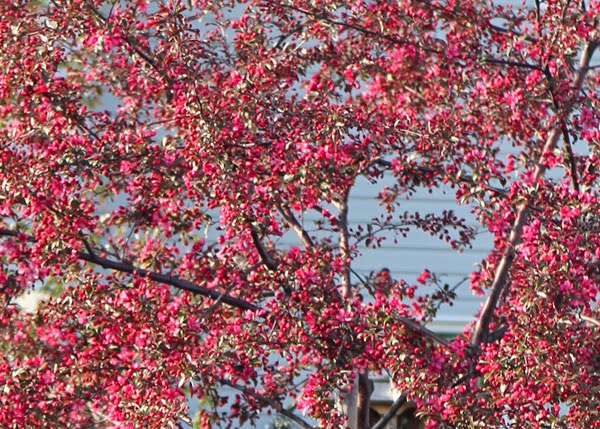
These photos of my three 'Royal Raindrops' crabapple trees are from May of last year. Maturing at 20 feet high and 15 feet wide, these trees will be a great size for my suburban backyard.

More information on this tree can be found here, on J. Frank Schmidt's website.

Lately I've been looking at a number of Schmidt's tree introductions. I wish I could collect bunches of them the way I do roses or perennials, but that's harder to do with trees!

Their list includes a number of smaller trees that are perfect for urban/suburban sites like my yard. I'm considering putting a couple of their 'Wireless Zelkova' trees in my front yard, even though the power lines in our neighborhood are buried, so we don't have to worry about the trees growing into the lines. But I love the spreading shape.

These crabapples put on a ton of new growth last year, since they are planted in great soil (imported, of course). In fact there are some longitudinal cracks in their bark from the fast growth rate, and I'm hoping they'll heal over all right.

Here you can see the fall color starting to show up. The leaves lighten and turn orangey. Our falls are too short to get the full fall color, though.

These are the bright little crabapples, which still cover the trees.

This is another sight that I'm looking forward to in May, which is a great month in the garden.
Added May 27, 2014 - Since this page is still getting a lot of views, I want to update with a little more information about my 'Royal Raindrops' trees. I still love these trees for their gorgeous spring blooms and fall color, plus the rich maroon leaves all summer. I don't appreciate all the little seedlings that sprout from the thousands of tiny crabapples that are produced each year, but if you planted these in the lawn, used heavy mulch around them, or spread Preen each year, you could eliminate most of that problem. I also have to prune them up regularly as the branches are almost weeping - though maybe you would like the weeping look. Here is a photo of the fall color last year.
The photo below was taken this spring just as the flowers emerged. They are vivid magenta at first and then fade to pale pink just before the petals fall.
Here is another shot from this spring. The lesson here is that if you plant trees in a mound of fluffy imported soil, you're going to need to stake them for several years until they get their roots down into the firm soil below. I didn't leave the stakes in long enough and that's why I have some leaners, but this wouldn't be a problem if you just planted them in the ground.











